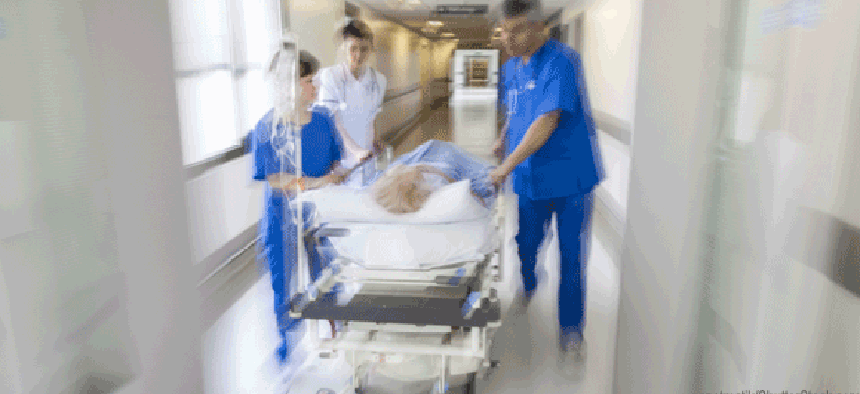Kentucky uses health network to divert 'frequent fliers' from ERs


Connecting state and local government leaders
The state launched an initiative to provide coordinated care for "super-utilizers," patients who overuse emergency departments and hospital inpatient services.
Like many states, Kentucky has been grappling with a disproportionate level of spending used to provide care to a tiny group of patients — the 1 percent or so who overuse hospital emergency rooms. Last year, state officials decided to do something about it.
Under a directive from Gov. Steve Beshear, the state launched an initiative with its Medicaid program to provide coordinated care for these “super-utilizer” patients -- also known as “frequent fliers--with the help of its secure electronic network.
Super-utilizers have long been a concern in Kentucky and elsewhere, but officials said they haven’t been able to effectively address their complex physical, behavioral and social needs so far. Dr. John Langefeld, chief medical officer for the Kentucky Department for Medicaid Services, said technology from data analytics to geomapping to communication is now helping officials connect super-utilizers with the right care.
“And we do think that’s what will create the difference moving forward from what we historically have experienced in a much more fragmented system,” he said.
Focus on super-utilizers has grown in recent years. In 2012, the Robert Wood Johnson Foundation provided funding to expand work done by Dr. Jeffrey Brenner to another half dozen cities. Brenner used data to map “hot spots” of the most costly patients in Camden, N.J., and then provided them with focused, collaborative care, reducing hospital visits and costs by as much as 50 percent. And last year, the National Governors Association chose seven states, including Kentucky, to share information and resources about different approaches to address super-utilization.
In analyzing its patient population data to identify the super-utilizers, Kentucky found that in one year about 350,000 Medicaid recipients used ERs at a cost of $341 million. Of those, a little more than half visited just one time and almost 45,000 patients went four or more times.
It identified 4,400 Medicaid recipients as super-utilizers, who used the ER 10 or more times at a cost of about $34 million. One patient used the ER 121 times while another visited 30 different ones. The state used a second criterion for these super-utilizers, who also had multiple inpatient admissions - three or more within a year.
And with Kentucky expanding its Medicaid rolls by an estimated 300,000 under the Affordable Care Act, hospital ERs could potentially see more.
State officials chose 16 hospitals - a mix of small and large facilities in urban to rural areas - to participate in program. One major requirement for inclusion was that they were connected to the Kentucky Health Information Exchange, or KHIE.
Polly Mullins-Bentley, executive director of the Kentucky Governor’s Office of Health Electronic Information, said the state began working on KHIE more than a decade ago in an effort to help healthcare providers quickly and securely exchange patient records, such as lab results, radiology reports, consultations and other information. The network, which launched in 2010, currently connects more than 800 locations with another 2,000 slated to be hooked up.
Langefeld said officials realized they needed to form coordinated care teams within these communities to better understand and holistically treat super-utilizers because many had behavioral and/or substance abuse problems as well as housing, hunger or transportation issues.
Kentucky officials said it’s still too early to provide measurable results, but Langefeld offered a scenario explaining how it could help.
For instance, ER providers may find nothing wrong with a patient who’s transported by ambulance, but they identify him as a super-utilizer. In this case, the ER would fire off a secure, real-time alert or notification through KHIE to other providers with information about the patient in case he shows up at their facilities. More importantly, coordinated care teams would be alerted to the super user and would have the responsibility to reach out to a patient, address his specific issues and provide treatment.
“The objective here is to steer this patient, this super-utilizer, away from the emergency department to a better place to receive primary care, which would be a patient-centered medical home, primary care provider or it might be the local health department,” said Mullins-Bentley.
Judy Hanover, research director with IDC Health Insights, said Kentucky’s use of its electronic network to share information about super-utilizers around the region is probably the most common example of how technology is being used for these cases. But providers are using other technologies to steer these patients away from the ER.
For example, remote health monitoring of patients with chronic conditions like diabetes or congestive heart failure can steer them to a primary care physician rather than an ER. Patients are also being encouraged to use smartphone apps or receive text messages from providers that remind them to take their prescribed medications, which is a problem for many.
“You rather head off a crisis early on and seek a more conservative treatment,” Hanover said.
Langefeld said the KHIE system has provided Kentucky with a different way of approaching the problem. The major challenge, he said, has been bringing together providers, such as local health departments and acute-care facilities, which have traditionally worked in silos and rarely interacted with each other.
Down the road, this project could lead to better communication among all healthcare stakeholders and connections among historically disparate data sets enabling better clinical decision making. Langefeld said the state plans to use data visualization and other technology tools to improve the effectiveness of the project.




